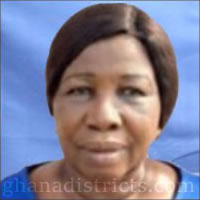Relevant Data
Location and Size
Currently, the District spans a total area of 780 square kilometers forming about 3.27% of the total land area of the region. Figure 1.3 shows the administrative map of the district.
Climate
The climate of the district is equatorial. It has a double rainfall maxima regime- with the major rainy season occurring between March and July. The minor rainfall season occurs between September and November. Mean annual rainfall ranges between 855mm and 1,500mm. The average number of rainy days for the year is between 110 and 120 days. The months, December to March are usually dry and characterized by high temperatures, and early morning moist/fog and cold weather conditions.
Temperatures are generally high throughout the year with mean monthly temperature of about 27ºc. Humidity is high during the rainy season. The months of December to February, however, record very low humidity. It must be stressed however that, current trends in the climatic conditions of the district is becoming unpredictable. This has however affected agriculture planning. The situation calls for measures to reduce the overeliance on climate for agricultural production.
Vegetation
Lying within the rain forest belt, the vegetation can best be described as moist semi-deciduous. The rain forest consists of three layers namely the Upper, Middle and Lower layers. The upper layer consists of the tallest trees, whereas the Middle and Lower layers consist of trees of lower height respectively. The forest abounds in different species of tropical woods of high economic value. These include Wawa, Odum, Mahogany Sapele, etc.
Relief and Drainage
The greater part of the district falls within a dissected plateau with heights reaching 800m to 1200m above sea level. The plateau forms part of the Mampong-Gambaga scarp. Many years of erosion has reduced the area to uniformly low height between 480m and 600m above sea level.
The district is drained by many rivers and streams. Notable among them are the Offin, Oyon and Abankro rivers. The Offin River takes it source from the Mampong scarp and flows between Boanim and through Bipoa to Afamanaso to Duaponkor and Amoako. At Nsuotem, it is joined by the Abankro River. The Oyon also flows from Banko in the Sekyere East District through Yonso in the Sekyere West District to Agona and joins the Offin River at Afamanaso. River Kunkum flows from Obomeng in the Sekyere East District through Asamang to Tano Odumasi and joins the Offin River. Continuous clearing of the catchment areas of the river and streams have adversely affected their flows.
Soil and Geological Formation
There are two geological formations in the district, namely, the Voltaian and Dahomeyan formations. The Voltaian formation was formed through deposition of sediments over a period of time. This mainly consists of sandstones, shale, mudstone and Lime-stone. The Dahomeyan formation is one of the oldest formations and it consists mainly of metamorphic rocks such as gneiss and schist.
The main soil types of the district consist of the Kumasi -Offin compound Association, Bomso-Offin Compound Association, Jamasi Simple Association, Boamang Simple Association, Bediesi-Sutawa Association and Yaya-Pimpimso Association.
The Kumasi-Offin Compound soil is ideal for the cultivation of tree crops such as cocoa, citrus, coffee and oil palm. They can also be cultivated for food crops such as plantain, cassava and cocoyam. The Boamang Simple Association is suitable for mechanized and subsistence agriculture but is highly susceptible to erosion and hence control of erosion on such soils are necessary.
The Bediesi-Sutawa Association has adequate water holding capacity and is suited for mechanized agriculture. They support crops such as maize, yams, legumes, cassava, plantain and groundnuts.
Date Created : 11/29/2017 2:54:36 AM




 facebook
facebook twitter
twitter Youtube
Youtube TOLL FREE 0800 430 430
TOLL FREE 0800 430 430 +233 593 831 280
+233 593 831 280 GPS: GE-231-4383
GPS: GE-231-4383 info@ghanadistricts.com
info@ghanadistricts.com Box GP1044, Accra, Ghana
Box GP1044, Accra, Ghana